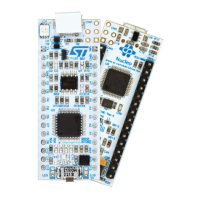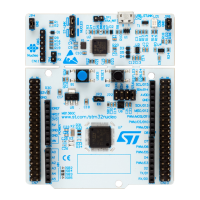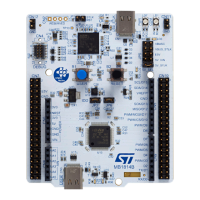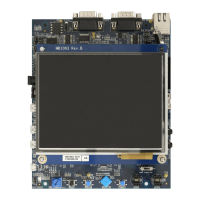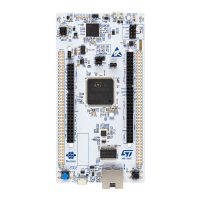Hardware layout and configuration UM1724
24/68 UM1724 Rev 14
6.7 OSC clock
6.7.1 OSC clock supply
There are four ways to configure the pins corresponding to the external high-speed clock
(HSE):
• MCO from ST-LINK: MCO output of ST-LINK MCU is used as an input clock. This
frequency cannot be changed, it is fixed at 8 MHz and connected to
PF0/PD0/PH0-OSC_IN of the STM32 microcontroller.
The following configuration is needed:
– SB55 OFF and SB54 ON
– SB16 and SB50
ON
– R35 and R37
removed
• HSE oscillator on-board from X3 crystal (not provided): for typical frequencies and
its capacitors and resistors, refer to the STM32 microcontroller datasheet. Refer to the
AN2867 Application note for oscillator design guide for STM32 microcontrollers.The X3
crystal has the following characteristics: 8 MHz, 16 pF, 20 ppm, and DIP footprint. It is
recommended to use 9SL8000016AFXHF0 manufactured by Hong Kong X'tals
Limited.
The following configuration is needed:
– SB54 and SB55 OFF
– R35 and R37 soldered
– C33 and C34 soldered with 20 pF capacitors
– SB16 and SB50
OFF
• Oscillator from external PF0/PD0/PH0: from an external oscillator through pin 29 of
the CN7 connector.
The following configuration is needed:
–SB55 ON
–SB50
OFF
– R35 and R37 removed
• HSE not used: PF0/PD0/PH0 and PF1/PD1/PH1 are used as GPIOs instead of clocks
The following configuration is needed:
– SB54 and SB55 ON
– SB16 and SB50 (MCO) OFF
– R35 and R37 removed
There are two possible default configurations of the HSE pins, depending on the version of
the STM32 Nucleo board hardware.
The board version MB1136 C-01 or MB1136 C-02 is mentioned on the sticker, placed on the
bottom side of the PCB.
The board marking MB1136 C-01 corresponds to a board, configured as HSE not used.
The board marking MB1136 C-02 (or higher) corresponds to a board, configured to use
ST-LINK MCO as the clock input.

